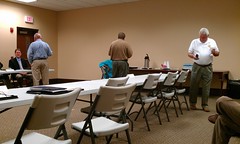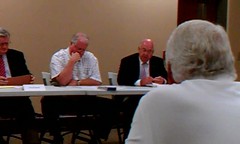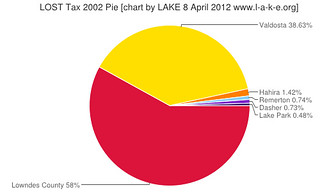 Here are videos of the
Local Option Sales Tax (LOST) talks yesterday morning
between Lowndes County and the local cities (Valdosta, Hahira, Remerton, Dasher, and Lake Park.
Not really negotiations, these were more an exchange of views.
The county’s position is the same as Chairman Ashley Paulk told me after
the county’s
four minute work session earlier that morning:
the county could claim 72% of LOST based on cost of services delivered
to the whole county,
but the county’s offer is to stick with the 58% share from 2002.
The cities all would like a bigger share.
Here are videos of the
Local Option Sales Tax (LOST) talks yesterday morning
between Lowndes County and the local cities (Valdosta, Hahira, Remerton, Dasher, and Lake Park.
Not really negotiations, these were more an exchange of views.
The county’s position is the same as Chairman Ashley Paulk told me after
the county’s
four minute work session earlier that morning:
the county could claim 72% of LOST based on cost of services delivered
to the whole county,
but the county’s offer is to stick with the 58% share from 2002.
The cities all would like a bigger share.
The venue was the county’s meeting room next to Commission Chambers. There was no sound feed available in there, so sound is variable.
First
County Manager Joe Pritchard explained
 the state-mandated procedures
and
Lowndes County’s position,
both of which were spelled out in a
three page paper.
Basically, the county wants to stick to the percentages negotiated in 2002,
although by the county’s reckoning it could ask for a much higher percentage.
the state-mandated procedures
and
Lowndes County’s position,
both of which were spelled out in a
three page paper.
Basically, the county wants to stick to the percentages negotiated in 2002,
although by the county’s reckoning it could ask for a much higher percentage.
 None of the cities had a written position paper.
Valdosta Mayor John Gayle noted Valdosta had grown more than the
county as a whole.
County Chairman Ashley Paulk responded that the city couldn’t grow
without the county growing.
The Mayor said nontheless most growth was in Valdosta.
The Chairman asked whether that was growth in households?
The Mayor said he didn’t know the answer to that right now.
The Chairman remarked that according to his reading of the census,
it was mostly not in households.
None of the cities had a written position paper.
Valdosta Mayor John Gayle noted Valdosta had grown more than the
county as a whole.
County Chairman Ashley Paulk responded that the city couldn’t grow
without the county growing.
The Mayor said nontheless most growth was in Valdosta.
The Chairman asked whether that was growth in households?
The Mayor said he didn’t know the answer to that right now.
The Chairman remarked that according to his reading of the census,
it was mostly not in households.
Hahira Mayor Wayne Bullard
 said Hahira had grown 26% in the past decade, and that was in households.
Plus Hahira provides several services of benefit to county,
such as housing EMS for the north of the county,
which costs Hahira $3,000 a year, while costs have gone up across the board.
said Hahira had grown 26% in the past decade, and that was in households.
Plus Hahira provides several services of benefit to county,
such as housing EMS for the north of the county,
which costs Hahira $3,000 a year, while costs have gone up across the board.
 Lake Park Mayor Ben Futch passed out a map and remarked,
“I could go on and on”.
He indicated a number of things inside Lake Park City limits that
benefit the county as a whole, and also complained that the VDT
sometimes identifies meth labs as being in Lake Park when they’re outside
the city limits.
I believe he said he thought Lake Park should get 0.67% of LOST funds
(the 2002 Lake Park share is 0.48%).
Lake Park Mayor Ben Futch passed out a map and remarked,
“I could go on and on”.
He indicated a number of things inside Lake Park City limits that
benefit the county as a whole, and also complained that the VDT
sometimes identifies meth labs as being in Lake Park when they’re outside
the city limits.
I believe he said he thought Lake Park should get 0.67% of LOST funds
(the 2002 Lake Park share is 0.48%).

The person from Mayor G.R. Holton of
Dasher (sorry; I have misplaced the name)
noted that Dasher had voted to remain a city, and had added
a zoning code and other things since then.
Dasher now has a population of 912, and depends 65% on LOST for
services for that population.
Dasher contracts mostly with the county for services, and also
with some private contractors.
It also decided not to seek industry, rather to serve as a bedroom
community.
Nonethless, Dasher would like to provide water and sewer, but cannot
without additional funding.
 Probation Officer Jessica Freeman, who also does planning and zoning
for Remerton (which is unique in being completely landlocked by Valdosta), remarked that Remerton would like to add an ion exchange
system for its water supply, and, like the other cities, could use more funding.
Probation Officer Jessica Freeman, who also does planning and zoning
for Remerton (which is unique in being completely landlocked by Valdosta), remarked that Remerton would like to add an ion exchange
system for its water supply, and, like the other cities, could use more funding.
 Chairman Paulk asked for further comments.
Hearing none, he said that the county has an offer out there,
and agreed with Mayor Bullard’s point that until the economy
in general improved, there was not going to be more money to go around
out of this pie.
Chairman Paulk asked for further comments.
Hearing none, he said that the county has an offer out there,
and agreed with Mayor Bullard’s point that until the economy
in general improved, there was not going to be more money to go around
out of this pie.
 Ben Futch had a question as to whether the county’s proposal was 72%.
County Manager Joe Pritchard clarified that it was to keep the
county’s share at 58%, and the cities could divide up the rest
however they liked.
Futch wanted to know where the sheet of percentages he was looking at came from.
Hahira City Manager Jonathan Sumner said he got it from the
Georgia Municipal Association (GMA).
Jessica Freeman wanted to know if the 2002 settlement was agreed to
by the county and the cities, or did it go to court, and was it
based primarily on population. Joe Pritchard said he had not seen it before.
Ben Futch had a question as to whether the county’s proposal was 72%.
County Manager Joe Pritchard clarified that it was to keep the
county’s share at 58%, and the cities could divide up the rest
however they liked.
Futch wanted to know where the sheet of percentages he was looking at came from.
Hahira City Manager Jonathan Sumner said he got it from the
Georgia Municipal Association (GMA).
Jessica Freeman wanted to know if the 2002 settlement was agreed to
by the county and the cities, or did it go to court, and was it
based primarily on population. Joe Pritchard said he had not seen it before.
 It sounds like the same percentages that were
in the VDT
that I used for
this pie chart.
It sounds like the same percentages that were
in the VDT
that I used for
this pie chart.
The VDT got a few comments from the cities after the meeting.
Here’s a video playlist:
Videos
LOST Negotiation,
Meeting with Mayors, Lowndes County Commission (LCC),
Valdosta, Lowndes County, Georgia, 9 April 2012.
Videos by John S. Quarterman for Lowndes Area Knowledge Exchange (LAKE).
Me, I think it’s great that the county and all the local cities are talking in a civil manner. However, I think they should spend their time talking about how to bring more revenue into the community by attracting clean industry for knowledge-based jobs.
-jsq
Short Link: